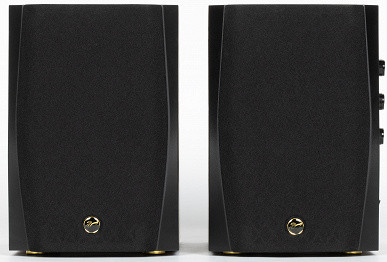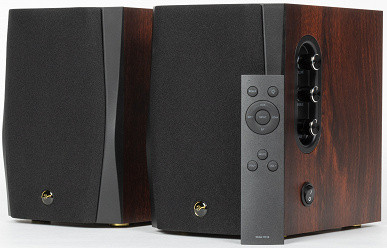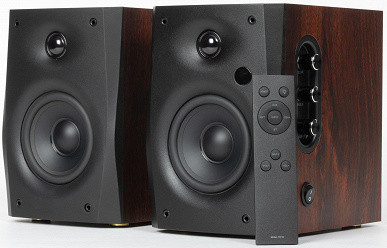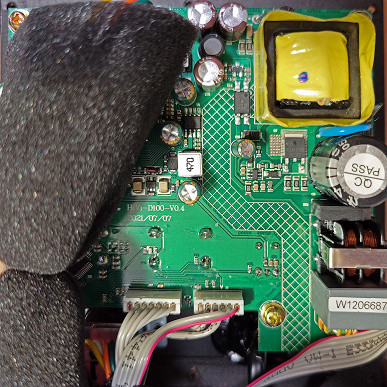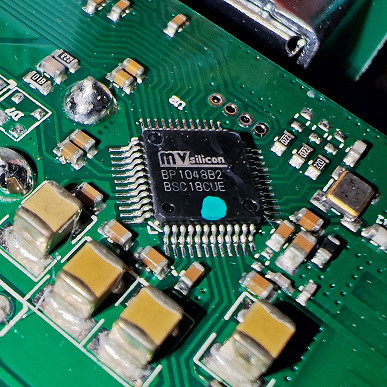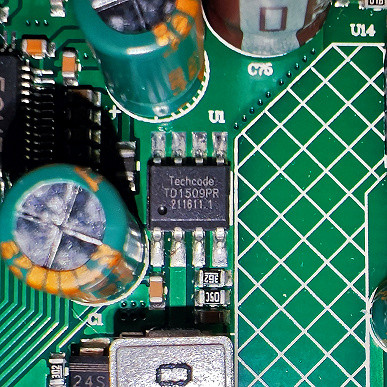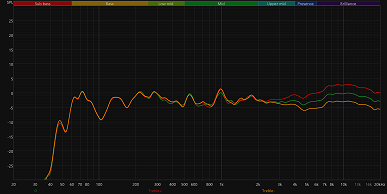Swan has earned a strong reputation in the field of acoustics. The company's history began in 1994 in Toronto, when Swans-Speaker Systems was founded. One of the key moments was the merger with the large Asian speaker manufacturer HiVi three years after its founding.
This merger allowed the new company Swans/HiVi to benefit from all of Swans' expertise, including unique technology and founder Frank Hale, who led the development of loudspeaker systems. They also inherited HiVi's manufacturing base, making them one of the leading manufacturers of loudspeaker systems and high-end drivers. For example, the company holds patents for isodynamic ribbon tweeters, which are widely used by other well-known brands.
Swans/HiVi also acts as an OEM, supplying speakers, enclosures and other components to many well-known brands, both individually and as complete units.
Particular attention is paid to Swan's own brand products, including high-end audiophile systems. Let's start getting acquainted with the company's products with the Swan D1100 speakers, small and accessible to a wide range of users, offered at a price of about $100 — $110 at the time of testing. These speakers promise compact size, a variety of connection options and potentially high-quality sound backed by the authority of the developer.
Declared technical characteristics
| Speakers |
|
|---|---|
| Frequency range (±3dB) | 60 Hz — 20 kHz |
| DSP Active Filter Frequency | 4 kHz |
| output power | 62W (RMS) |
| Tone control | yes, HF and LF (±3 dB) |
| Inputs |
|
| Supported codecs | SBC |
| Dimensions of one column (H×W×D) | 216×155×215 mm |
| Weight |
|
Packaging and accessories
We received the acoustics, packed in two boxes. The first of them is a transport one, made of unpainted cardboard. The box contains brief characteristics of the device, the manufacturer’s logo and the slogan “Hear the difference.”
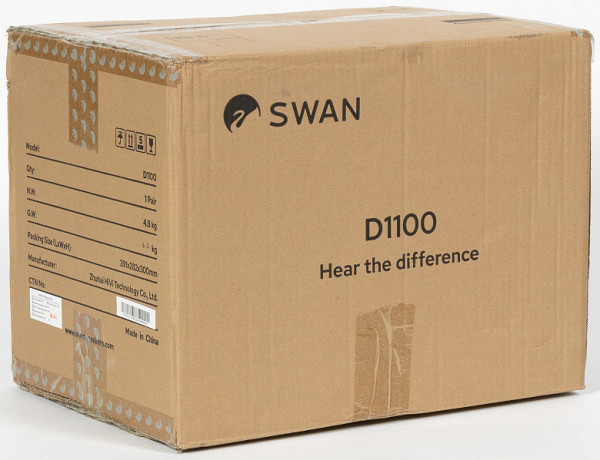
Well, the second one is the “front” one, it looks prettier due to its black color and full-color image of the device. A plastic handle is provided for carrying; inside the speakers and accessories are securely held using foam holders.
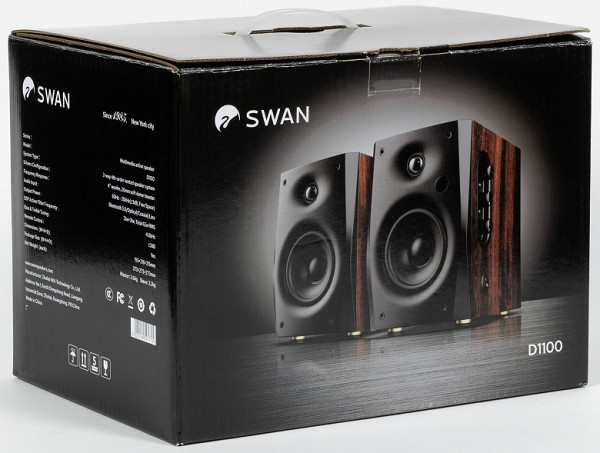
The delivery set includes the acoustics itself, cables for connecting to a sound source and an active speaker to a passive one, a remote control, and documentation.
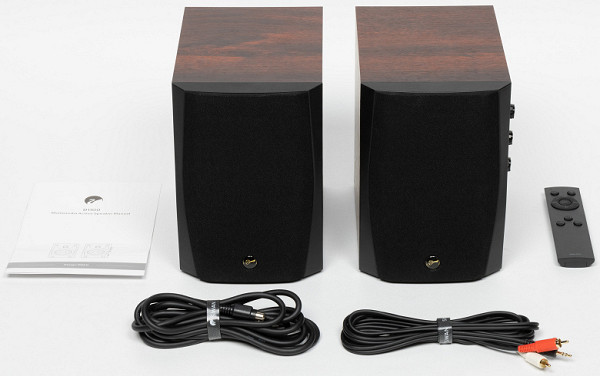
The control panel runs on two AAA batteries; their compartment is located on the rear panel — we will look at it in more detail in the corresponding section of the review. The kit includes batteries for the remote control, but our test unit did not have them, so they were not included in the photo above.

The cables really deserve attention. They have a solid cross-section, but at the same time flexible, with a pleasant-to-touch braid and high quality workmanship. The kit even includes branded zip ties. The minijack-RCA audio cable for connecting to a sound source is 2 meters long.
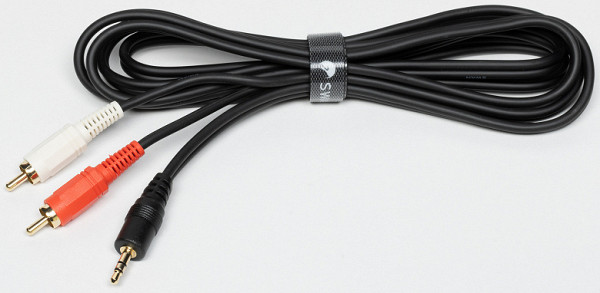
To connect a passive speaker to an active one, a special cable with two four-pin connectors is used. Its length is 3 meters, which allows you to conveniently position the speakers and create an expressive stereo effect.
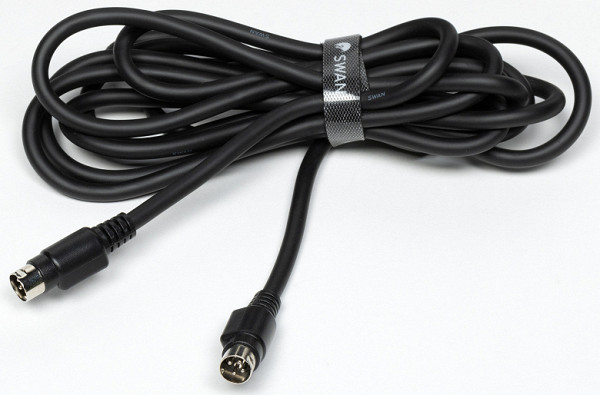
Appearance
Swan D1100 has a nice appearance, but is made without unnecessary decorative elements, which allows it to easily fit into the interior. The only slight disappointment is that there is only one color available: the MDF body is neatly covered with brown vinyl film with a wood-like texture.
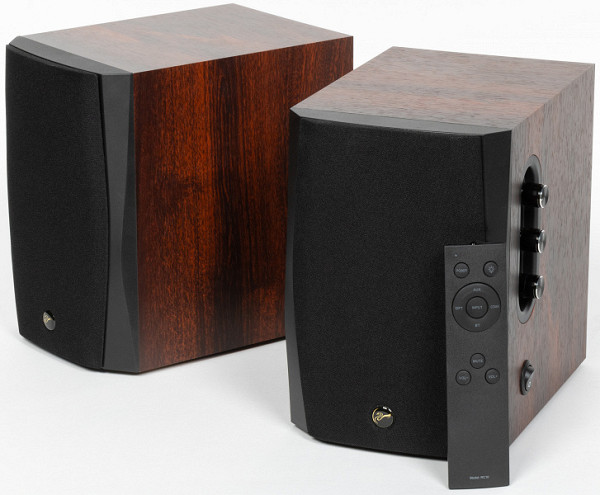
The grilles on the front panel are covered with black sound-proof fabric, with a small manufacturer's logo located at the bottom.
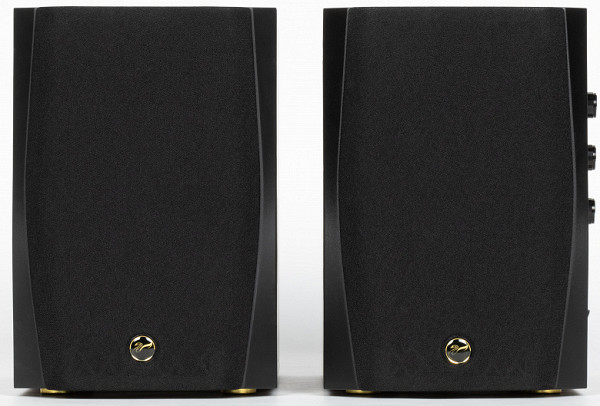
The grilles are secured with four plastic pins and can be easily removed and then reinstalled. Although the fasteners are quite thin, there is little doubt about their reliability. However, it is recommended to avoid frequent removal and installation of grilles to avoid possible damage. However, this is not required in everyday use.
Without grilles, the acoustics take on a more expressive look — the matte black front panel with unusual curves stands out. If there are no children, pets or other potential hazards around, you can leave the speakers without grilles for a more aesthetically pleasing appearance. However, this is, as always, a matter of personal preference.
Another benefit from removing the “grills” is that the LED indicator on the front panel of the active speaker becomes more visible. It is also noticeable through the fabric of the grille, but sometimes not as well as we would like.
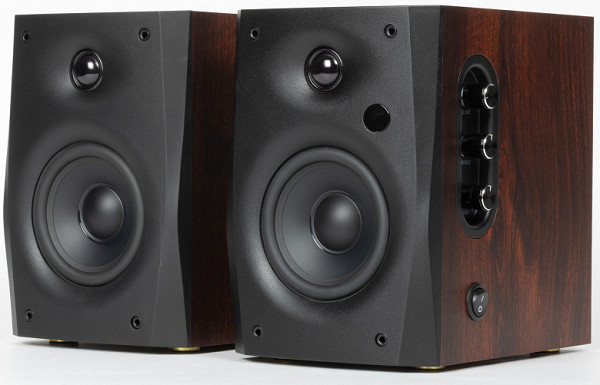
The indicator is multi-colored and shows which input source is active, and also informs you when the maximum volume level has been reached. The bottom speaker has a diameter of 10 cm and is responsible for reproducing mid and low frequencies.

The tweeter responsible for the high-frequency range with a silk dome with a diameter of 20 mm is located inside a small horn.
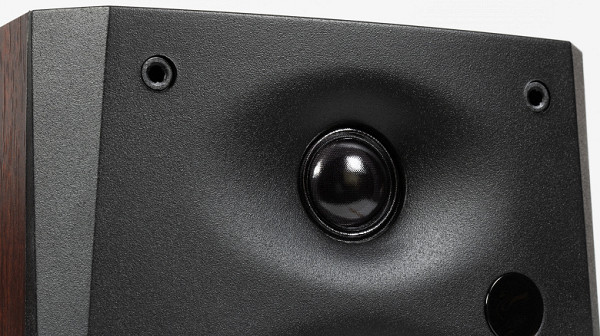
All walls of the acoustics are neatly covered with vinyl film, which is completely resistant to dirt and stains from touch, and can be easily cleaned if necessary.
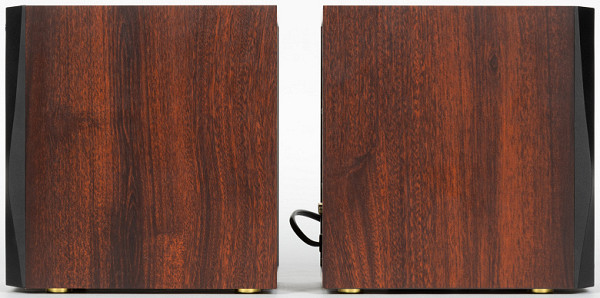
On the right side panel of the active speaker there are volume and tone control knobs, plus a two-position power switch.
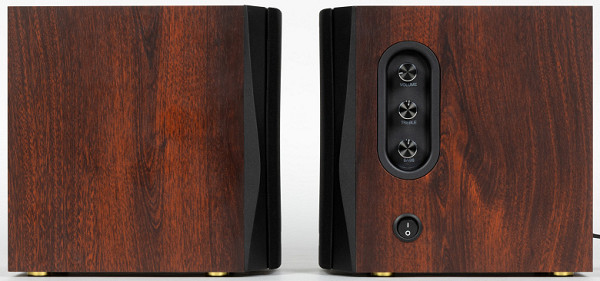
On the rear wall of the speakers there are bass reflex ports and two panels. The active panel has several ports for connecting sources and a built-in 1.5 meter long power cable; On the passive panel there is a connector for connecting to the active speaker.
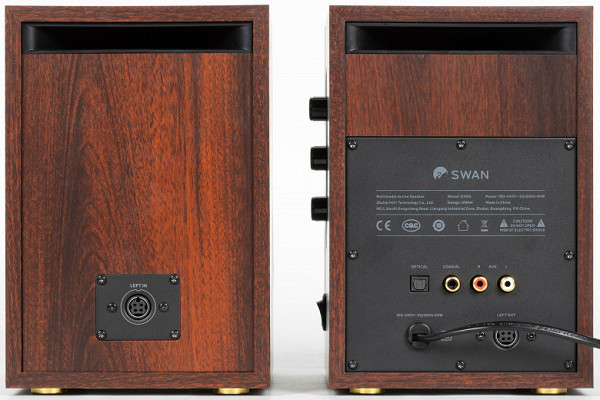
The bass reflex has an unusual design with a slot-like external port, known as a «Double Diffusio rectangular inverting tube,» according to the manufacturer.
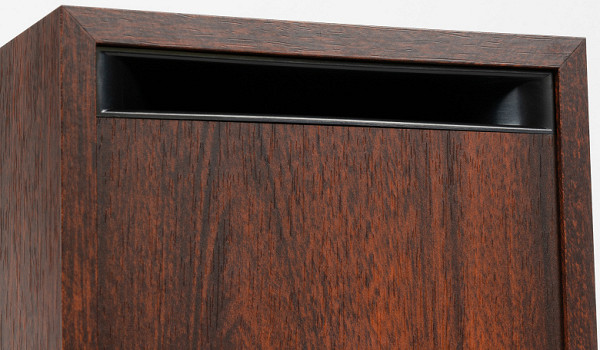
The legs of the Swan D1100 turned out to be solid for their compact size. They are 20mm in diameter and are attached with screws rather than glue. These legs reliably ensure the stability of the speakers on a horizontal surface and partially absorb unwanted vibrations.
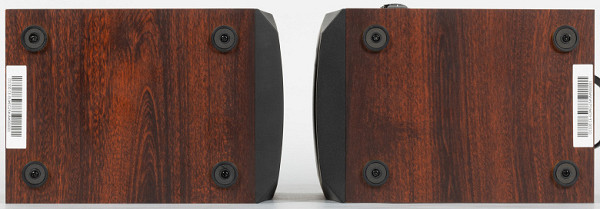
Construction
The metal panel on the back of the active speaker is easily removable, and we took advantage of this to take a look inside the device. The first thing that catches your eye is the presence of damping material inside. It is not secured particularly carefully, but is held well due to its volume. This is important because recently manufacturers have often overlooked the need to reduce unwanted resonances within the speaker cabinet.

There are no markings on the speakers; most likely, they were manufactured by HiVi — the use of the developer’s own components seems more logical. The power supply is placed on the same board with everything else and is practically unshielded — but for compact budget speakers this can be forgiven.
The ESMT AD82584F is used as a DAC/DSP/amplifier — an entry-level solution that corresponds to the budget class of speakers. The maximum power in mono mode reaches up to 50 W, but the power supply provides only 40 W, as indicated on the back of the connection panel. The specifications claim 62W of power, which may be questionable given the limitations of the power supply. The practice of over-specifying power has been around for a long time and is common practice in the industry.

Bluetooth connectivity is provided by the MVSilicon BP1048B2 chip, which is widely used in budget and some higher-end devices where wireless communication is not the main function. Voltage conversion is done using Techcode TD1509PR.
Connection
To connect the active speaker to the passive speaker, a supplied cable is provided, which was mentioned earlier. It's simple: one end is connected to the active speaker connector, and the other to the passive speaker connector. It's almost impossible to make a mistake.
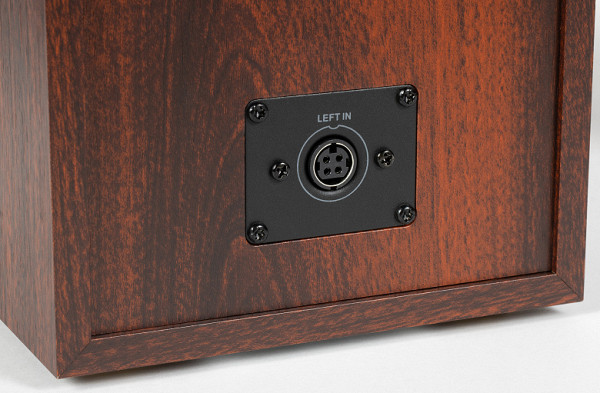
The rear panel of the active speaker has connectors for connecting audio sources. An analog cable is included, but digital cables (coaxial or optical) must be purchased separately. It's a bit of a pity that there is no separate subwoofer jack, although its necessity may be controversial. One of the main advantages of the Swan D1100 is their compact size, which may mean that their users will not want to add a subwoofer to the system, even if there is space to install it under the table. But if there was such a way out, it would be very convenient.
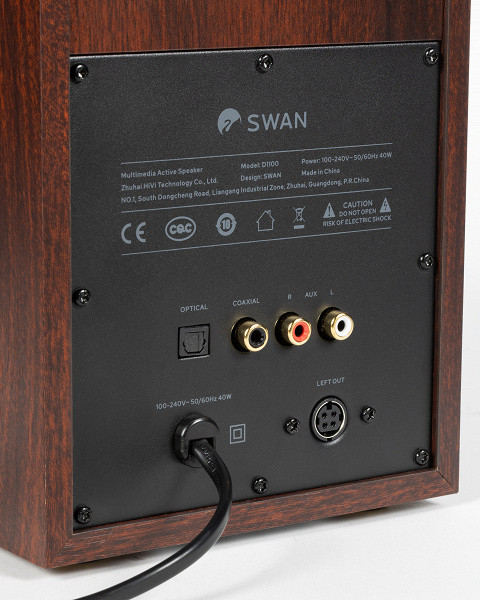
The connectors are conveniently located on the rear panel of the speakers, they do not overlap and are easily accessible. Do not place the speakers too close to walls or other obstacles due to the rear-facing bass reflex port. The connectors protruding above the surface of the rear wall are designed precisely for this purpose — to prevent this possibility.

The mechanical power switch has a nice «analogue» click that we've come to miss a little in the era of all sorts of touch controls that are ubiquitous — regardless of their relevance and convenience.

After activating the Bluetooth connection, the speaker scans for “familiar” devices for a while. If it doesn't find them, it goes into pairing mode. Next, all the steps are standard: find the acoustics in the corresponding menu and connect it.
The Swan D1100 does not support multipoint; using the Bluetooth Tweaker utility, we traditionally obtained a complete list of supported codecs and their modes.

The speaker supports only one codec — SBC. At the same time, the maximum value of the Bitpool parameter is set at 250, which is significantly higher than the recommended High Quality profile, where the recommended value is 51. This allows the speaker to work at maximum capabilities, sufficient for listening to music in the background.
Management and Operation
On the side wall of the active speaker there are controls for controlling the main parameters of the acoustics. The topmost one is responsible for adjusting the volume and raises certain questions. This is an encoder with no rotation limit, so its position is not a reliable indicator of volume level. The lack of a small screen showing the current level is made worse by the fact that the LED indicator only signals when the maximum value has been reached.
It is noticeable that the handle has a completely uninformative line that can mislead the user. The user can reduce the volume to minimum and then turn the control a little more — as a result, the position mark will not correspond to the actual volume level. This phenomenon is not unique to this model, indicating common practice. We hope that this approach does not become common, as it significantly reduces usability.
The controls for switching active inputs work flawlessly — pressing occurs with a pleasant slight force and a soft click. The bass and treble controls are also well made: they have a limited rotation angle, smooth operation and locking in the middle position.
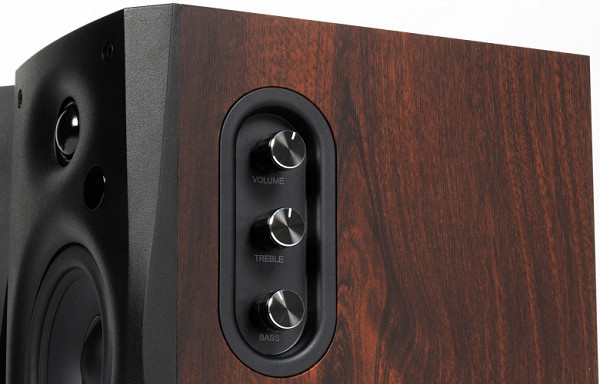
The front panel indicator is bright enough to be visible even in bright daylight, especially if the front grilles are removed. It is also quite visible through the fabric grilles, but in very bright light you may need to look a little closer. By changing colors, it informs the user that the currently selected input has been activated, mute mode has been activated, and the maximum volume level has been reached. However, it is worth noting that even a pair of seven-segment indicators would cope with these tasks more effectively.

The control panel is compact, the buttons are pressed easily and with a pleasant click. Another innovation is the placement of the active input selection on the “ring” at the top, which is unusual for the usual volume and tonal balance controls. However, this location is also convenient, especially considering that the volume keys are located at the very bottom of the remote control, are large and easy to feel under your fingers.

Sound and frequency response measurements
The dimensions of the Swan D1100 speakers are 155x216x215 mm — these are compact dimensions, despite their sufficient size. They are capable of reproducing full-fledged bass with a frequency of 60 Hz, which corresponds to the declared characteristics. The “smooth” and balanced middle especially stands out, which is rare in budget monitors.
The high-frequency range sounds without characteristic disadvantages, such as sibilance or the sound of “sand”. While you shouldn't expect perfect detail or volume from the Swan D1100 speakers, they are an excellent example of great sound for compact multimedia speakers. This is confirmed by the frequency response graph obtained as part of our review using a measuring microphone placed at a distance of one meter on the axis of the tweeters.
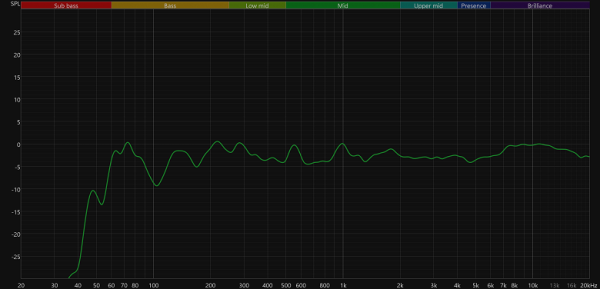
The bass on the Swan D1100 speakers is noticeable at the bass reflex tuning frequency, which leads to pronounced peaks in the cumulative spectrum attenuation graph, or “waterfall”. However, it sounds unusually balanced, perhaps due to the special design of the resonator. The presence of such low frequency range in such compact speakers is in itself a significant achievement.

We have already shown more than once that the frequency response is practically independent of the selected input, however, sometimes the built-in DSP can surprise with unexpected effects. In this case, there were no such surprises — another good news.

The tone block is configured delicately, but at the same time effectively. The bass control has a noticeable effect on the mid-range, preventing it from being emphasized too much. This is easily explained: from such a compact body and with such a woofer size, it will be difficult to squeeze out even more low frequencies without increasing distortion or “boominess”.
The level of horizontal dispersion is predictably not very good, so the Swan D1100, like any compact tabletop acoustics, should be pointed directly at the listener's head.
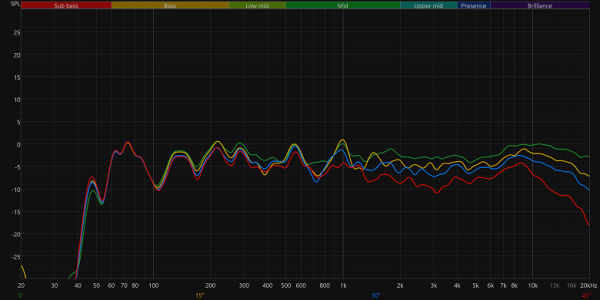
It is especially important to monitor the vertical arrangement of the speakers, which is often overlooked by many users. Even a slight elevation of the measuring microphone by 20 cm can significantly distort the sound: high frequencies become almost inarticulate. Therefore, when listening in the near field, it is important to place the speakers at the level of the listener's head. For this purpose, special stands, shelves or even boxes, stacks of books are useful — anything to direct the speakers towards the listener, and not away from him.

Results
The main advantage of the Swan D1100 is their compact size, excellent sound for multimedia acoustics and affordable price. Of course, there are some drawbacks, for example, not very convenient controls, which require getting used to. However, if you establish interaction with the remote control and get used to the control features, then these minor shortcomings may not be noticed over time. Otherwise, considering the price-quality ratio and compactness of the speakers, the Swan D1100 model seems to be a very attractive choice. If you're looking to save space and money without sacrificing acceptable sound quality, these speakers are worth a closer look.

